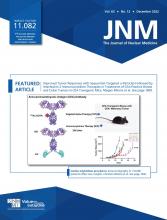SNMMI and Lobular Breast Cancer Alliance Research Grant
The SNMMI Mars Shot Fund and the Lobular Breast Cancer Alliance announced on October 3 that applications are being accepted for the new and jointly sponsored $100,000 Invasive Lobular Carcinoma (ILC) Research Grant. This initiative, a first-time collaboration between the 2 organizations, aims to fund a research project focused on advancing ILC breast cancer imaging and treatments to improve patient outcomes.
To be selected, research projects must focus on ILC and molecular imaging or therapy for lobular breast cancer. Priority projects may have molecular imaging as the primary focus of the proposed research, or, alternatively, researchers may investigate methods that integrate other imaging and/or molecular science with radionuclide methods, including hybrid imaging techniques such as PET/CT, SPECT/CT, and PET/MR imaging. Patient advocates will be included as voting members in the application review process.
Applications are due by December 15. Additional information on application and proposal submission is available at: https://www.snmmi.org/AboutSNMMI/Content.aspx?ItemNumber=41839&utm_source=Email&utm_medium=Informz&utm_campaign=Email%20Outreach&_zs=iOqn91&_zl=qKHr6.
SNMMI
DOE Breaks Ground for Stable Isotope Production and Research Center
The U.S. Department of Energy (DOE), in coordination with Oak Ridge National Laboratory (ORNL; TN), on October 24 held a groundbreaking event on the ORNL campus for the Stable Isotope Production and Research Center (SIPRC), which will expand the nation’s capability to enrich stable isotopes for medical, industrial, and research applications. DOE also announced $75 million to support the SIPRC with funding provided through the Inflation Reduction Act, which in FY 2022 delivered $1.55 billion to the Office of Science to accelerate national laboratory infrastructure projects.
SIPRC will provide DOE with multiple production systems that can enrich a wide range of stable isotopes. The facility includes space to add additional systems and expand the building footprint in the future as demand increases. SIPRC will be part of the DOE Isotope Program, which produces and sells isotopes that are in short supply or otherwise unavailable. The research conducted at SIPRC supports the Program’s innovative work to develop advanced manufacturing techniques and novel isotope separations to build out a safe and reliable domestic supply chain.
The facility is scheduled for completion in 2025 and will be housed in the same space as the Enriched Stable Isotope Prototype Plant. SIPRC will establish a domestic full-production cascade for enriched stable isotopes. It will also reduce the nation’s reliance on foreign sources of enriched stable isotopes by facilitating new capabilities to produce useful quantities of priority stable isotopes. This will address the void left when operation of the Oak Ridge calutrons ceased in 1998.
U.S. Department of Energy
NIH to Investigate Function of Every Human Gene
The National Institutes of Health on September 27 announced the launch of a program intended to better understand the function of every human gene and to generate a catalog of the molecular and cellular consequences of inactivating each gene. The Molecular Phenotypes of Null Alleles in Cells (MorPhiC) program, managed by the National Human Genome Research Institute (NHGRI), aims to systematically investigate the function of each gene through multiple phases that will each build on the work of the previous.
The program will be funded initially for 5 y for a total of $42.5 million. Phase 1 of the program will focus on 1,000 protein-coding genes and serve as a pilot phase, with 3 goals: exploring multiple methods of inactivating (knocking out) gene function, developing molecular and cellular systems that model multiple human tissues and developmental stages, and developing molecular and cellular approaches to cataloging gene function that other researchers can reproduce.
“The function of thousands of genes is still a mystery, and they likely serve vital biological roles,” said Colin Fletcher, PhD, NHGRI program director in the Division of Genome Sciences. “Understanding fundamental biology can help us figure out why certain diseases occur and how we can develop drugs to target and treat those diseases.”
More than 6,000 of the estimated 19,000 protein-coding genes have not been well studied. Among those that have been studied, only small subsets of their functions are well characterized. All data over the course of the project will be made available to the broader research community. If Phase 1 is successful, NIH will activate a second phase to characterize a larger set of human genes.
“MorPhiC is meant to add another layer of functional information between the gene knockout at the DNA level and the organism-level effects. We want to catalog the effects of knocking out each gene within cells and—together with information from other studies—use that to understand how genes function to produce an organism,” said Adam Felsenfeld, PhD, NHGRI program director in the Division of Genome Sciences. Recipients of funding for phase 1 of the MorPhiC program include researchers at Northwestern University Feinberg School of Medicine (Chicago, IL), the University of California San Francisco, Sloan Kettering Institute for Cancer Research (New York, NY), Jackson Laboratory (Farmington, CT), and the University of Miami (FL).
National Institutes of Health
- © 2022 by the Society of Nuclear Medicine and Molecular Imaging.







